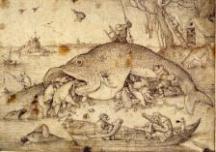Period Band B
Bosch and Bruegel in Netherlandish Art
Tutor: Jeanne Nuechterlein
Description
This module centres on two outstanding early Netherlandish artists, Hieronymus Bosch (c. 1450-1516) and Pieter Bruegel the Elder (c. 1525-1569). Both artists have posed particular problems for interpretation, given their idiosyncratic subject matter and style. Bosch has typically been seen as a unique visionary of medieval sensibilities, given the demons and temptations pervading his images, although more recently art historians have recognized his popularity with educated audiences and his connections to popular culture.
A few decades later Bruegel took inspiration from Bosch to produce works like The Triumph of Death, Fall of the Rebel Angels, and the Virtues and Vices print series, but he also painted landscapes and peasant scenes that communicated moral messages in a more 'naturalistic' fashion. In this module we will study the meaning of these artists' works in the context of their historical and cultural circumstances. Were their artworks intended to be enigmatic or obvious to their viewers? Were they really that unusual compared to other artistic and cultural currents of the day? How did the forms and functions of art change in the 16th-century Low Countries? What accounts for their popularity, then and now?
Objectives
By the end of the module, students should have acquired:
- knowledge of the lives and works of Bosch and Bruegel
- an ability to analyze the specific forms of their artworks in comparison with others of their era
- understanding of changes in artistic forms and functions from the late 15th to the mid-16th century in the Low Countries
Preliminary Reading
There are several fairly inexpensive introductory books available on Hieronymus Bosch and Pieter Bruegel the Elder. Many of these are primarily useful just as picture references, but the following have very good text and are reasonably priced too in paperback:
Laurinda S. Dixon, Bosch (Art & Ideas series), Phaidon, 2003
Philippe and Roberta Roberts-Jones, Bruegel (Master Artists), Flammarion, 2012 (also available in a larger-format earlier edition called Pieter Bruegel)
Larry Silver, Peasant Scenes and Landscapes: The Rise of Pictorial Genres in the Antwerp Art Market, University of Pennsylvania Press, 2005 (paperback 2012)
Three more expensive but excellent monographs are:
Manfred Sellink and Till-Holger Borchert, Bruegel: The Complete Paintings, Drawings and Prints, Ludion/Abrams, 2007
Larry Silver, Hieronymus Bosch, Abbeville Press, 2006
Larry Silver, Pieter Bruegel, Abbeville Press, 2011
There are also some older books with longer text still in print that you can pick up very cheaply, although you should bear in mind that they will not include the latest research. The best of these are by Walter S. Gibson from the Thames & Hudson World of Art series (Hieronymus Bosch published in 1973, Bruegel published in 1977).
If you are not already familiar with the northern Renaissance period in general, I recommend reading either of the following texts:
Craig Harbison, The Art of the Northern Renaissance, Lawrence King, (also published under the title The Mirror of the Artist: Northern Renaissance Art in its Historical Context, 1995—note it's the same book!)
Jeffrey Chipps Smith, The Northern Renaissance (Art & Ideas series), Phaidon, 2004
These are both relatively short and inexpensive. They cover a wider geographical area than we will in the course (all of northern Europe not just the Low Countries) and a longer time-span (the fifteenth as well as the sixteenth century), but that will help you gain a sense of the wider context. Another overview of this broader geographical area and time-span, but with much more depth and detail, is:
James Snyder, revised by Henry Luttikhuizen and Larry Silver, Northern Renaissance Art: Painting, Sculpture, the Graphic Arts from 1350 to 1575, 2nd edition, Upper Saddle River, NJ: Prentice Hall, 2004
This is a good investment if you are interested in the northern Renaissance more broadly, though again we will only address a small proportion of this material in the module.

Module Code HOA00019H
